Vince Darcangelo's Blog, page 12
December 6, 2013
Review: Backwards
Backwards
By Todd Mitchell
Did you know there is no adjective form of the word “integrity”? Look it up. I was going 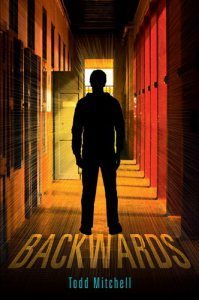 to open this review with a declaration of how integritous we are here at Ensuing Chapters. Or is the word I’m looking for integrian? Integrilicious?
to open this review with a declaration of how integritous we are here at Ensuing Chapters. Or is the word I’m looking for integrian? Integrilicious?
None of the above.
Nevertheless, that’s my silly way to introduce a serious (and seriously good) book with the requisite disclaimer: I have known Todd Mitchell, the author of the young adult novel, Backwards, for about three years, studied under him and served as his teaching assistant in a nonfiction writing class. It’s important to establish this up front, because this will be a glowing review, and I can say with all integrity that the praise is deserved, not spooned out because I know the author.
And with that out of the way, let’s jump to the end. Or rather the beginning. Sort of.
Backwards begins with a teenaged boy, Dan, dead in the bathtub from an apparent suicide. Standing over the scene is our narrator, a Rider (a kind of immaterial wandering soul) who isn’t sure where he is, who he is or how he got there. It doesn’t take him long to realize that he is experiencing time in reverse. We observe Dan’s suicide and his preparations, his daily habits and behaviors, and once we meet pre-dead Dan, it’s easy to diagnose his terminal condition.
I believe the clinical term for it is: He’s an asshole.
But as time bends backward, we pick up more and more fragments of Dan’s life. Yeah, he’s an asshole, but he’s a teenager. Is that so odd? And maybe there’s something dark and vulnerable driving his bad behavior. Indeed there is, but he is also supported with love and encouraging voices, which he silences through self-deliverance.
This is a difficult book to describe, and I’m sure far more difficult to write. Mitchell, however, pulls it off. He taps a mainline to those cringe-worthy cafeteria moments when every little thing was life or death. High school was uncomfortable the first time, and doesn’t seem much better the second time around.
At least not at first.
The narrator, who is living Dan’s life in reverse, provides the wide-angle view that teenagers tend to lack. Actually, it’s a comforting vantage point, and if Dan could’ve seen his life from this perspective, he probably wouldn’t have ended up in the bathtub.
As I’ve often told youth groups as an addictions counselor: Teenagers aren’t stupid. Teenagers just do stupid things. That’s an important distinction, which becomes clear as we watch Dan try to make the right choices, but stumble along in that ham-handed manner that I recognize from my own high school memories. There are missed opportunities, mixed signals, mistaken intentions, the right words left unspoken and the worst ones screamed out loud.
Sound familiar?
That’s the beauty of Backwards. Though the time-manipulated narrative can be disorienting, we are grounded in the familiarity of Dan’s world. Sure, the fashion has changed, but the angst is the same as it always was and will be—and even that elicits a weird nostalgia. Even someone like me, who hated high school and all its cliques, will appreciate its stabilizing force within this chaos.
I also appreciate that the novel isn’t preachy. Of course, the message is clearly against suicide, but Mitchell isn’t talking us off the ledge with niceties. The truth can be vicious, and the author doesn’t recoil from the abyss. Through the character of the Rider, he digs into the horrors of high school and tries to come to terms with the trauma.
Is the Rider successful? The better question is, does it even matter? I’m not well-versed in literary theory, but at its core, Backwards, despite a dash of the spiritual realm, is an existentialist anthem.
Longtime readers know my affinity for existentialist anthems.
My point is that perhaps understanding your awkward years is better than changing them. By revisiting our past, we can be struck by how small everything looks in comparison. If only Dan could’ve seen what the Rider sees.
At least that’s the view from my early 40s. I’m not sure how a young adult would read it, but there’s no doubting the importance of Backwards for its intended audience. But I would argue that Backwards is as much, if not more, of a must-read for adults.
And I’d bet my integritude on that.


November 29, 2013
Review: Fangasm
Fangasm: Supernatural Fan Girls
Katherine Larsen and Lynn S. Zubernis
While I enjoyed Fangasm from page one, I have to admit I was confused at first. What I  thought would be an academic account of fan culture, particularly surrounding the TV show Supernatural, turned out to be something altogether different.
thought would be an academic account of fan culture, particularly surrounding the TV show Supernatural, turned out to be something altogether different.
Two professors—Katherine Larsen and Lynn S. Zubernis—geek out over the hunky stars of their favorite television show, attending conventions, joining an online community and penning racy fan-fic, all the while discussing the book they were going to write.
Unfortunately, this wasn’t that book.
The original output of their research was the 2012 academic study, Fandom at the Crossroads: Celebration, Shame and Fan/Producer Relationships. Fangasm, on the other hand, is the reporter’s notebook of their exploration.
Once I realized this, I settled in and thoroughly enjoyed the ride. Along the way, the authors feed each other’s “squee”; stalk hunky TV stars; and struggle with strained family relationships, their careers and even their friends. It’s a riotous, road-trip affair, and it’s refreshing to see the lighter side of the uptight academic.
But there’s a serious side to the book as well. In exploring fan-fiction, the duo encounters a diverse body politic. A bulk of the viewer-produced literature is sexual in nature—and due to the make-believe subject matter, and the lack of publisher gatekeeping, fan-fic writers often delve into places even pornographers fear to tread. (Hint: the show’s leading men, though not actually related, play brothers on Supernatural—take that ball and run with it.)
Also on the serious tip are the self-esteem issues that arrive. Unfortunately, the shaming of fangirls is not limited to the mainstream community. While the conventions can be a refuge for those who otherwise feel displaced from society, there is an internal enforcement of etiquette that can be just as stratified and exclusionary as the mainstream. It’s a dark and curious sociological paradox.
Ultimately, I would have preferred to geek out with the academic text, but hey, there is no wrong way to get your nerd on. While I don’t approach the level of fanboy status held by Larsen and Zubernis, I know my way around a convention, and I’ve spent thousands of dollars on rare books, albums and KISS memorabilia. I can relate to this duo, and I find it refreshing to learn about a pair of obsessed academics letting their geek flag fly.


November 27, 2013
Review: Language, Cognition, and Human Nature
Language, Cognition, and Human Nature: Selected Articles
Steven Pinker
I love science and science writing, and when people ask me why, I have a simple answer: Because I really don’t get most of it. I have a scientific curiosity and 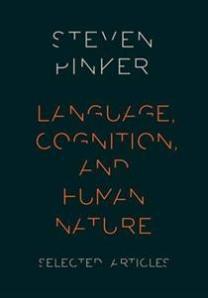 mathematical brain, but if it weren’t for the grading curve, I’d still be taking Freshman biology.
mathematical brain, but if it weren’t for the grading curve, I’d still be taking Freshman biology.
I’ll never fully grasp the writings of Richard Dawkins or Stephen Hawking, but I love reading them. They pique my interest, and I always come away learning something. Maybe it’s my fear of becoming cognitively rigid in middle age, but the prospect of a static or shrinking intellect keeps me up at night. I’m well past the point of exploring texts that merely reinforce my current knowledge base.
Which brings us to Steven Pinker and his new collection of articles, Language, Cognition, and Human Nature: Selected Articles.
While pursuing my master’s degree, I wasn’t feeling challenged in my English coursework, so I signed on for a semester of Philosophy of Language. I loved it, but I can still barely understand half of it. I did learn one thing, though: I kick ass at propositional logic, but predicate logic turns my brain to creamed corn.
So I was excited to read this collection, which Pinker prefaces with a curious introduction concerning general interest science writing. He talks of the popularity of scientists who are able to write for a popular audience (and science writers who can serve as a go-between), but argues that we’re underestimating readers with this approach. Rather than spoon-feeding the masses distilled information, Pinker provides us with the source material: his actual academic articles.
This is not light reading, and be warned it is challenging.
But it is enjoyable and enlightening. If you haven’t tried to wrap your mind around language theory, you need to read this book. Even if you don’t understand half of it, what information you glean will radically affect your relationship with language and the mind.
If nothing else, it’s a head trip—no lab coat required.


November 15, 2013
Review: Skyway
Bill DeYoung
Skyway: The True Story of Tampa Bay’s Signature Bridge and the Man who Brought it Down
It’s hard to elicit raw terror in book form, especially in the opening pages. If the book is 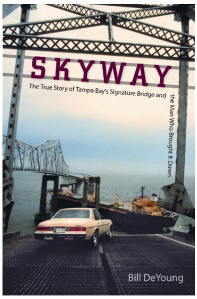 300 pages, you know there is still plenty to come. Real life, however, is a gut-wrencher. For instance, there’s no guarantee I’ll finish writing this review—or that you’ll finish reading it. That’s why well-crafted nonfiction, such as Bill DeYoung’s Skyway, can induce frights greater than most horror novels.
300 pages, you know there is still plenty to come. Real life, however, is a gut-wrencher. For instance, there’s no guarantee I’ll finish writing this review—or that you’ll finish reading it. That’s why well-crafted nonfiction, such as Bill DeYoung’s Skyway, can induce frights greater than most horror novels.
I white-knuckled it through the first two chapters of Skyway, a recounting of the Skyway Bridge disaster of 1980, and was impressed with DeYoung’s narrative talents from stem to stern.
Some background: In 1980 a harbor pilot, John Lerro, was guiding a ship to the Port of Tampa. A freak storm unleashed a nightmare scenario, and without radar or visibility, the ship, the Summit Venture, struck the bridge, collapsing a span of road 150-feet high. Thirty-five vehicle-bound victims, including passengers in a Greyhound bus, plummeted to their death.
It’s a tragedy mostly forgotten outside of Florida, but DeYoung’s brilliant account should change that. With a narrative journalism style, he fleshes out the events of that morning with factual data, news reports and first-hand accounts. We share the helpless terror of the Summit Venture crew as cars plunk into Tampa Bay. We white-knuckle it as a car grinds to a halt inches from the drop. We cheer as motorists band together to halt oncoming traffic and shut down the bridge, saving countless lives.
And then the book really gets good.
DeYoung, a longtime journalist, gives us a longitudinal view of the disaster, from the rise of interstate commerce that necessitated the bridge to the haunted lives of the Skyway survivors decades later. Some of the most interesting bits concern the role the interstate system and mid-20th century financial culture played in building the bridge (and cutting corners from construction to upkeep).
Though it was Lerro who took the blame, it was greed that forced the harbor pilots to take chances in foul weather. Also in play was the exclusionary, good-old-boy culture of the harbor pilots, which deeply scarred Lerro (who was exonerated of any wrong-doing, and in fact was commended for preventing more deaths) following the tragedy.
Skyway put me in mind of Nathaniel Philbrick’s In the Heart of the Sea: The Tragedy of the Whaleship Essex, which is about as high a compliment as you can pay an author of narrative history. Maybe I’ve just got a thing for maritime disasters (I blame Poe and Arthur Gordon Pym for that), but Skyway is a chilling, informative and deeply engrossing narrative.
This is a book worthy of awards and deserving of the bestseller list.


November 13, 2013
Review: A Brighter Word Than Bright
A Brighter Word Than Bright
by Dan Beachy-Quick
Although A Brighter Word Than Bright is about Romantic poet John Keats, I couldn’t get 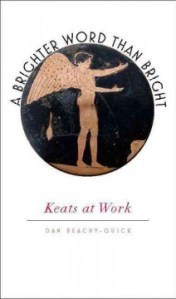 my favorite Oscar Wilde quote out of my head while reading it: “Man is least himself when he talks in his own person. Give him a mask, and he will tell you the truth.”
my favorite Oscar Wilde quote out of my head while reading it: “Man is least himself when he talks in his own person. Give him a mask, and he will tell you the truth.”
It’s a cruel irony that nonfiction is thought to be the most accurate medium for Truth—reducing reality to the recitation of facts. If that were so, then the minutes of a company meeting should have more cultural sway than Shakespeare, right? Yet when I was in London, there were scores of young and old gathered at the gates of the Globe Theatre.
I didn’t take a poll, but I’m confident that when people think of London in 1599 (when the original Globe was built), they think of Shakespeare rather than that year’s landmark court ruling, Edward Darcy Esquire v. Thomas Allein of London Haberdasher, which established the foundation for modern antitrust law.
I didn’t see anyone perusing court transcripts outside the Globe.
That’s why Dan Beachy-Quick’s biography of Keats is so refreshing. Rather than retelling his life story or critiquing his work through some previously unexploited element of his personality, Beachy-Quick gives us the biography of the poet’s imagination.
Which, of course, requires a lot of imagination.
No shortage there. Beachy-Quick, author of nearly a dozen collections of poetry, essays and criticism, weaves a fever-dream narrative that treats its subject as more putty than marble, so that Keats, the man, vanishes at times.
Or perhaps Beachy-Quick brings us so close we no longer recognize him.
Either way, A Brighter Word Than Bright engages the reader’s imagination, and the author states from the beginning that:
“I have little interest in offering a portrait of Keats more accurate than those already available… I am more concerned with returning Keats, as best I can manage, back into that half-light that obscures accurate rendering so as to make more brilliant those sudden flashes in his poems and letters that, lightning-like, reveal the storm-tossed grasses in the ceaseless field even as darkness closes the vision again—sudden clarities, and the afterimage that lingers long past the lightning’s strike.”
Our subject is deliberately blurred, grated into the environment with an opacity that is oddly revealing. From an early age, Keats is displaced, yet absorbed by the world. Or perhaps consumed is more like it. Beachy-Quick sketches a grief-burdened man-child weeping beneath a desk for his dead mother. Yet, the boy is not separate from the desk, nor the desk from the room. All is connected in this tragic tableau: “Some music sobs up into song. Some song digs down and confronts what it also must comfort.”
Keats is tormented by his talents, a gift on par with Greek tragedy. Much like Darrin McMahon’s Divine Fury: A History of Genius, Beachy-Quick views genius as something that possesses, rather than something one may possess:
“To listen to genius is to let oneself be guided by that voice in the self that is not the self’s own. It implies an otherness exactly where we expect to find identity; it speaks within us a rumor to us, that we are least ourselves where we are most ourselves.”
This duality zigzags throughout the book, at times we are uncomfortably close and at others removed, disoriented, flipping between past and present tense to remind that art, and the artist’s struggle, belong to all ages. That like Keats’ poems, all is absorbed into a timeless moment—infinity in a single instant and vice versa. (Beachy-Quick cleverly enforces the point with reference to the work of the paradox-obsessed Greek philosopher Zeno.)
As we progress chronologically, Beachy-Quick peppers in some academic critique, for example going through the Odes and incorporating Keats’ letters for context. I was particularly struck by one passage from Keats to his wife, Fanny Brawne:
“I have two luxuries to brood over in my walks, your Loveliness and the hour of my death. O that I could have possession of them both in the same minute. I hate the world; it batters too much the wings of my self-will, and would I could take a sweet poison from your lips to send me out of it.”
Would it be fair to say Keats was the first emo kid?
Actually, that may be as fair as any other portrait. No biography has been able to capture the man in full, which certainly adds to his appeal. Beachy-Quick, with this unconventional and highly original biography, gives us something better than the Truth. He gives us the febrile terror that inhabits the artist’s soul.


November 12, 2013
Review: The Faceless One
The Faceless One
Mark Onspaugh
The prologue of Mark Onspaugh’s The Faceless One is a primal delight. We begin in 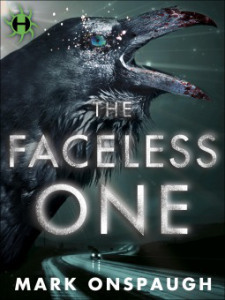 the forested snow-scape of rural Alaska, 1948, where young Jimmy Kalmaku embarks on a dark journey with his uncle deep into the tundra. Hidden within a remote cave is an evil of which Jimmy has never imagined.
the forested snow-scape of rural Alaska, 1948, where young Jimmy Kalmaku embarks on a dark journey with his uncle deep into the tundra. Hidden within a remote cave is an evil of which Jimmy has never imagined.
It is also where he learns that he will succeed his uncle as shaman and inherit the task of keeping the Faceless One locked up in that cave.
The uncle says, “Remember our path today… I hope you need never come this way again, but you must remember.”
Clearly, we are not finished with the cave.
And neither is Jimmy.
With this spine-tingling opener, Onspaugh has swirled together the elements of great storytelling: odyssey, myth, duty, loss of innocence. There is a sad inevitability in this scene. Present are the generations of tribesmen, forward and back, guarding this secret place—a never-ending watch against something that exists outside of timespace. Something hallowed. Something in the blood.
Onspaugh has a tender touch that imparts soul into this icy epic which spans generations and locations, jumping ahead to present day when Jimmy, now an elderly man, learns that an archeologist has displaced the mask keeping the Faceless One captive.
With the ancient evil unleashed, Jimmy is called to action. He must remember his uncle’s words… and the way to that dark place.
Releasing this book on Oct. 28 is brilliant marketing—not simply because October is a good time for horror fiction, but because the setting of The Faceless One is a set-piece for a chilly night. What better time than when the veil between the worlds is thinnest to encounter a shapeless evil? To follow its trail from Alaska to New York to Seattle and beyond.
From generation to generation, blood to blood.


November 11, 2013
Review: Skull in the Ashes
Skull in the Ashes: Murder, a Gold Rush Manhunt, and the Birth of Circumstantial Evidence in America
by Peter Kaufman
University presses aren’t usually known for producing pot-boiling thrillers, but that’s 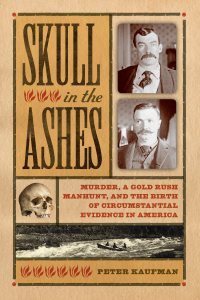 what the University of Iowa Press has done with Skull in the Ashes. In 1897, the quiet eastern Iowa town of Walford was awoken by a fire at the general store. When the flame had died, they discovered a charred corpse with some belongings of the store’s owner, Frank Novak, who often slept there.
what the University of Iowa Press has done with Skull in the Ashes. In 1897, the quiet eastern Iowa town of Walford was awoken by a fire at the general store. When the flame had died, they discovered a charred corpse with some belongings of the store’s owner, Frank Novak, who often slept there.
The timing was curious as Novak, heavily in debt, had recently purchased multiple life insurance policies.
Oh yeah, and the skull they found in the ashes had been bashed in, which is atypical behavior for your run-of-the-mill house fire.
Here, the lives of three men intertwine: Novak; M.J. Tobin, the new county attorney; and Red Perrin, a near-superhero whom we’ll discuss later.
There may have been a time when folks wouldn’t have asked too many questions about the fire, odd though it was, but Tobin utilized emerging forensic tools—such as dental records—to identify the corpse as someone other than Novak. Tobin’s quest crossed multiple state lines and even involved the famed Pinkerton National Detective Agency. But the trail went cold in the Pacific Northwest.
Enter Red Perrin.
Perrin was a detective in Arizona who had a reputation for tenacity and toughness. He was the only one trusted to venture into the Yukon and return Novak alive.
The amount of research that went into this book is evident. Kaufman worked his butt off on this book, and he does a good job of balancing information with narrative. Where he is strongest, though, is following Perrin—which, ironically, was probably the toughest to recreate. The trek through the mining territory is difficult. Perrin hires a team, hikes for days through the mountains and brings along with him a boat builder.
That’s right, a boat builder.
On the other side of the mountain pass was a treacherous waterway, which Perrin would need to traverse to get up to the mining camp where he suspected Novak was living under an assumed name. But they couldn’t carry a boat through the mountains, so once completing that leg of the journey, Perrin and his partner chopped down trees and built a craft sturdy enough for the rapids.
That’s pretty bad ass.
Skull in the Ashes is divided into three parts, and this is by far my favorite. Part one is the story of Novak and Tobin; the town of Walford; and the crime and initial investigation. It’s a bit like a murder-mystery, although we already know whodunit. The narrative here is about history and evidence, and I really enjoyed this section.
Part two is an adventure tale. Kaufman creates lavish scenery, strong characters, high tension and the thrill of a pulp wilderness expedition. I think of it as Thoreau’s The Maine Woods meets The Fugitive. The plotting is well-paced, and Kaufman rightly pulls back on the history and lets the action take center stage.
Which brings us to part three: the aftermath. Unfortunately, this is where Kaufman runs out of bullets. It’s not his doing, but simply the climax of the story. The final part covers Novak’s trial and incarceration and ties up the storylines of all involved. As with the other sections, it is well-researched and –written, but we spend too much time on the trial.
I did enjoy the sociological aspects of the book’s conclusion. Kaufman describes prison life at the time and reforms that were making it more humane. There is also the importance of the Novak trial for its use of forensics and circumstantial evidence. Kaufman clearly describes a time of transition in American history: the advance of science, the sophistication of law enforcement, and the expansion and opening of the world, such that a local crime committed in small-town Iowa would involve the federal government, multiple states, two countries and a wilderness chase.
And so Iowa, and America, looked ahead to the 20th century.
To sum up, Skull in the Ashes is a thrill ride for history buffs and fans of narrative nonfiction and an unexpected, and delightful, blend of pulp and scholarship.


November 10, 2013
Review: Divine Fury
Divine Fury
Darrin M. McMahon
Since 1981, the MacArthur Foundation has bestowed its “genius grant” on 873 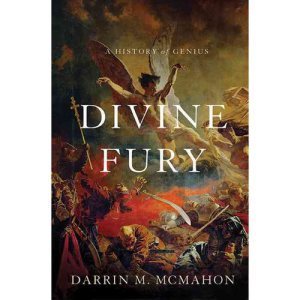 (ostensibly) geniuses—“talented individuals who have shown extraordinary originality and dedication in their creative pursuits and a marked capacity for self-direction,” reads the MacArthur Web site.
(ostensibly) geniuses—“talented individuals who have shown extraordinary originality and dedication in their creative pursuits and a marked capacity for self-direction,” reads the MacArthur Web site.
But is this the truest definition of “genius”? Considering that the title is so commonly conferred upon basketball coaches, celebrities and rock stars (a recent Rolling Stone article referred to Kanye West as a “mad genius”—seriously), is being a “genius” even that impressive anymore?
In Divine Fury, historian Darrin M. McMahon isn’t questioning MENSA credentials so much as tracing the history of this loaded term and how it’s changed over the centuries.
Our etymological quest begins with the ancient Greeks, for whom being a genius was a form of madness. McMahon culls pithy quotes from Plato revealing a lesser-known side of Socrates: He was quite haunted. (This from the Phaedrus dialogues—no wonder the brilliant 20th century philosopher/madman Robert Pirsig chose Phaedrus as his alter ego in Zen and the Art of Motorcycle Maintenance.)
Whereas contemporary culture views genius as something you possess, ancient philosophers believed the inverse: Genius possesses you. More specifically, a demon possesses you, for good and ill, and this was the belief for centuries. McMahon documents many cases of “genius,” from the ancients to modern times, and how the concept evolved and then devolved into our current celebrity-obsessed culture.
It’s a curious evolution, and one I wouldn’t have thought about much before reading Divine Fury. McMahon deftly illuminates this secret and complicated history through literary accounts, keen observation and a strong narrative. His writing can be a bit tangential and academic at times—but hey, the man’s an academic! What do you expect?
I certainly wasn’t expecting to think about genius as a populist concept, but there it is. In some ways, the history of genius is the flow of agency from the elite to the proletariat. While I would rate that as a good thing, an unfortunate consequence is that genius has become just another noun that anyone can claim.
The change is due in part to advanced medical knowledge. In ancient Greece, Socrates believed a demon was whispering in his ear. Today, we’d slip him some Paxil.
Or give him his own TED talk.
Ultimately, it remains a fuzzy line between madness and genius. Is it the possessed or the possessor? Are 98th percentile test-scorers (the threshold for MENSA membership) the elite or merely outliers? Or is each of us capable of becoming an Einstein?
No matter, from now on I’ll be slower to label someone a genius.
Unless that “mad genius” Kanye West splits the atom in his next video.


September 28, 2013
Shine On
When civilization was rebuilding following an inter national plague, the epicenter of humanity was Chautauqua Auditorium in Boulder, Colo. At least that’s how it happened in Stephen King‘s The Stand, an epic tale of apocalypse, atonement and the will to persevere.
national plague, the epicenter of humanity was Chautauqua Auditorium in Boulder, Colo. At least that’s how it happened in Stephen King‘s The Stand, an epic tale of apocalypse, atonement and the will to persevere.
So it was fitting that, in the aftermath of the floods that devastated Colorado’s Front Range, particularly Boulder, a crowd of more than 1,200 gathered in Chautauqua on Sept. 26.
But this time it wasn’t to hear from Stu Redman or Mother Abigail. It was to hear from the man himself.
“This is where the first Boulder Free Zone meeting was held, right here in this auditorium,” King said early in his talk before a sell-out crowd.
King, his wife Tabitha and two of their children briefly lived in the city in the mid-’70s, following the publication of King’s second book, ‘Salem’s Lot. He authored two of his most famous novels in the shadow of the Flatirons, The Stand and The Shining.
So it’s only fitting that he returned to Boulder to celebrate the release of Doctor Sleep, the long-awaited sequel to The Shining.
“I wanted to see if my old King Soopers was still there,” King joked, referring to the grocery store in his former South Boulder neighborhood.
It’s still there, as is the Stanley Hotel an hour up the road in Estes Park.
First published in 1977, The Shining was King’s first hardback bestseller. And while most folks are familiar with the Stanley Kubrick interpretation, the film featured a few exterior shots of Boulder and nothing of the Stanley Hotel on which it was based. (The Stanley is now home to ghost tours, Halloween galas and the Stanley Film Festival—and I highly recommend the pilgrimage.)
King recalled fondly his mountain writing studio and the inspiration he felt there.
“It was the greatest writing time of my life,” he said, though he doesn’t recall the specifics of creating the actual books. “I only remember that I was happy. I was engaged. I think most imaginative writing is like that.”
King’s innate talent and creativity was likely aided by a progressive, anything-goes attitude of a college town in the foothills undergoing the growth spurt that transformed it into one of the country’s top-rated cities—an epicenter of technology, education and craft-brewed beer.
“I stopped to pick up a hitchhiker one day, on Broadway, and I got rear-ended,” King said of one of his more interesting Boulder memories. “The hitchhiker ran off, and I got cited.”
A second vehicular mishap provided the inspiration for another King classic. His car broke down in Boulder Canyon, and he was walking into town for assistance. While crossing a bridge, he noticed the clack of his cowboy boots on the wooden planks. He wondered: What might be underneath this bridge listening to his footfalls?
Perhaps a clown—and thus the seed of Pennywise, the supernatural killer in It, was planted.
But the book he was really here to talk about was Doctor Sleep, which hit shelves on Sept. 25.
“People kept asking me whatever happened to Danny Torrence,” he said. “I decided, finally, that I would try to write a sequel.”
He was fascinated, he said, with the cyclical nature of family dysfunction, how children of abusive or alcoholic parents tend to repeat that behavior as adults. So it’s fitting that Danny’s adult life is, well, complicated.
Now in his 40s, Danny is a hospice worker in New Hampshire, where, along with the help of an intuitive cat, he helps suffering patients come to rest. But though the novel begins in New England, it inevitably takes to the road.
And that road could only lead to one place.
“Eventually, he has to go back to Colorado and to Boulder,” King said.
He read excerpts from Danny’s return to the city, which involved a particularly nasty hangover and an over-the-top gross-out gag that will have his most hardened readers choking up.
It is a sequel decades in the making, and a return to one of King’s greatest triumphs. This is a treat for long-time fans, and new ones. During the Q&A, a question came from a fan who started reading King in their youth, and now their kids are reading the books.
“I think it’s nice when people pass the book down from generation to generation,” King said.
But his literary legacy includes more than his books and films. It also includes his offspring. His youngest son, Owen, is the author of Double Feature, and his oldest son is best-selling author Joe Hill. Joe and his dad have collaborated on two novellas and often share ideas when writing their books. For example, they were simultaneously working on Doctor Sleep and Hill’s NOS4A2, and each included a scene in which their characters cross paths.
“In a strange way, it’s almost like writing with another part of myself,” King said of his collaborations with Joe.
Doctor Sleep will certainly bolster the already absurdly rich King oeuvre. It will take readers back to some cherished places, both physical and psychic: Boulder, the Overlook Hotel and one of the finest and most terrifying works of psychological horror ever penned.
And together, we will once again croak our favorite and most-haunted mirrored phrase: RedRum.


September 10, 2013
Trending Now: Trollies
Thomas Cathcart
The Trolley Problem, or Would You Throw the Fat Guy off the Bridge?: A Philosophical Conundrum
David Edmonds
Would You Kill the Fat man?: The Trolley Problem and What Your Answer Tells Us about Right and Wrong
Not since Rice-a-Roni has the trolley car been so popular.
What started as a philosophical thought experiment (first posed in the 1960s by  British philosopher Philippa Foot) has become fodder for barroom chautauquas and classroom debates. It goes a little something like this: You are the conductor of a runaway trolley, and you’re headed toward five men working on the track. You have no way to stop or slow down, and you know that all five men will die.
British philosopher Philippa Foot) has become fodder for barroom chautauquas and classroom debates. It goes a little something like this: You are the conductor of a runaway trolley, and you’re headed toward five men working on the track. You have no way to stop or slow down, and you know that all five men will die.
Then, you notice a side track, and by simply pulling a switch, you’ll reroute the trolley and spare the workers. However, you see another man on this side track. The worker will surely die, but this lone death will save five.
Do you pull the switch?
What makes the trolley problem so interesting is that it can be reframed in many ways, all essentially asking the same question: Is it better that one person dies in order to save five lives?
The utilitarian gut response is usually affirmative, but the problem gets trickier as you introduce different scenarios. The darkest and most humorous of these is the fat guy on the bridge. Rather than the conductor, you and an obese stranger are on an overpass looking down at the track. In this scenario, there is no side track and no way to reroute the train away from the workers. The only way to spare their lives is to stop the trolley… and the only way to do that is by pushing the obese man off the bridge.
That’s quite the game-changer. But yet, the principle question remains the same: Is it better that one dies to save five?
This dilemma has moved from the classroom to cultural conscience thanks to the work of philosopher Michael J. Sandel and his book/mooc/PBS lectures on justice. This fall, two more intellectual titans offer their take on this ethical dilemma.
In The Trolley Problem, or Would You Push the Fat Guy off the Bridge?: A Philosophical Conundrum, published Sept. 10, Thomas Cathcart presents the arguments before a judge and jury, albeit fictitious. Cathcart is best known for a series of books coauthored with Daniel Klein that explains complicated philosophical ideas through jokes and anecdotes, and as with these bestsellers, like Plato and a Platypus Walk Into a Bar…, the tone is light and irreverent.
Though the jests overshadow the ethics, there is some substance to the work. Ethical arguments are accompanied by short bios of their progenitors, and the introduction and conclusion put forth serious thought.
That said, the jokes amount to insider baseball. The greatness of Cathcart’s other books is that they serve a general audience. The humor in The Trolley Problem, or Would You Push the Fat Guy off the Bridge? is geared toward a readership already familiar with the thought experiment.
Those familiar with the work of Sandel and Foot will enjoy this short, light-hearted laugher. Those looking to explore the complexities of the dilemma should look elsewhere, get up to speed, and then dig into this trial by philosophy.
At least Cathcart gives us something the others don’t (sort of): a juried decision. The final verdict?
You’ll just have to read it for yourself.
The trolley debate gets a deeper look on Oct. 6, with David Edmonds‘ Would You Kill the Fat man?: The Trolley Problem and What Your Answer Tells Us about Right and Wrong.
Edmonds is co-host of one of my favorite podcasts, Philosophy Bites, which has spawned two books and  brought contemporary and historical philosophical concepts to a general audience.
brought contemporary and historical philosophical concepts to a general audience.
His treatment of the trolley problem traces the history of moral philosophy and modern ethics with the entertaining flair he brings to Philosophy Bites.
Though covering the same topic, these two books offer complementary takes on this complicated thought experiment. Fans of philosophy, moral inquiries or deep thinking in general will enjoy both of these fine book.





